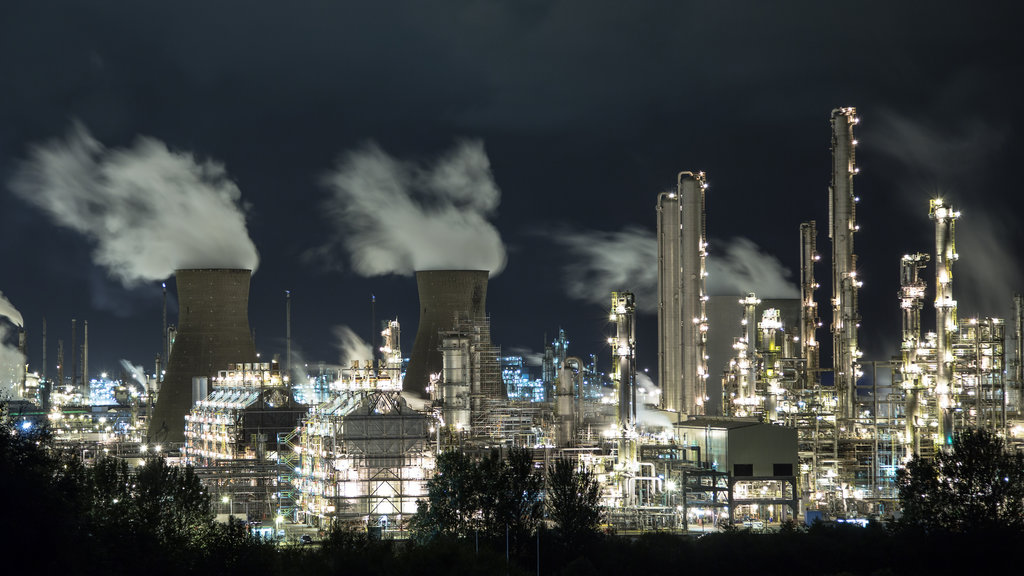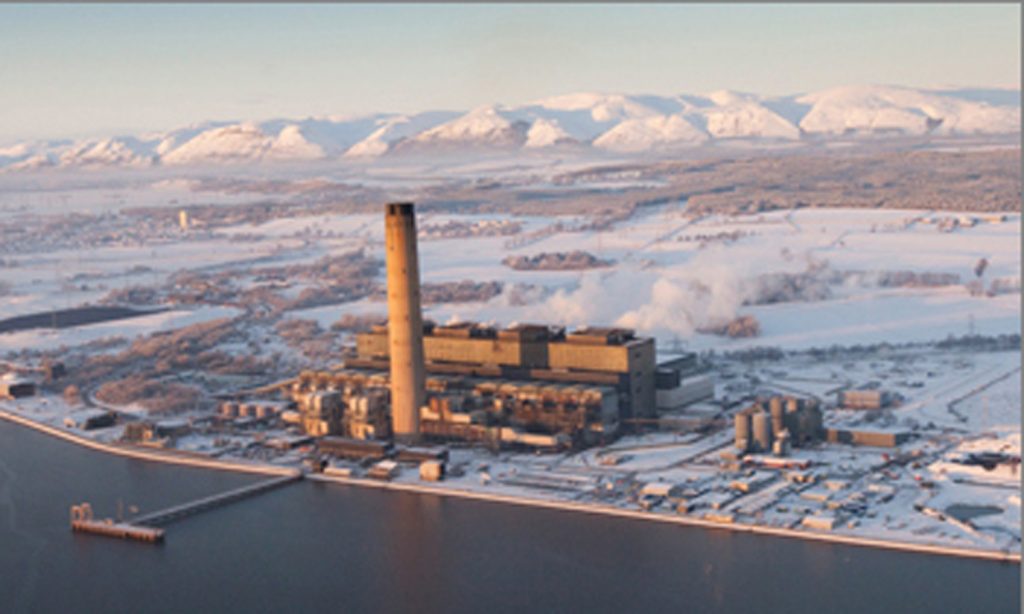In Search of Post-Carbon Scotland
 Christopher Silver on how the politics of geology have helped define a post-industrial Scotland that awaits a clear alternative.
Christopher Silver on how the politics of geology have helped define a post-industrial Scotland that awaits a clear alternative.
In October 2017 the Scottish Parliament voted overwhelmingly to support an indefinite ban on fracking. The move was, correctly, deemed historic. For the first time after centuries locked-in to the business of a carbon-based economy, seams of fossilised wealth were to be left in the ground. The landscape would be unaltered, its hidden riches untouched.
Some 60,000 responses were received as part of the Scottish Government’s consultation on the matter – double the number submitted to a similar exercise on the Scottish Independence Referendum. The vast majority expressed concerns about fracking.
Though it escaped widespread media attention, INEOS recently won the right to seek damages from the Scottish Government over this outcome. The company has brought an old-school capitalist swagger in demanding that its thirst for Scottish shale gas is quenched. Enormous ‘dragon ships’ emblazoned with the words “SHALE GAS FOR MANUFACTURING” now regularly ply their way towards Grangemouth laden with fracked gas from Pennsylvania in what the company terms a “virtual pipeline” across the Atlantic.
But in considering the strength of feeling about the rights and wrongs of fracking, we risk forgetting Scotland’s sense of itself as a nation is inextricably bound up with fossil fuels. Change is never as simple as it proclaims.
Had the accident of geology not dumped accessible deposits of coal in close proximity to navigable waterways, Scotland would not have been launched upon the world, nor would it have found itself in the vanguard of the Industrial Revolution. It was in this modern Scottish nation that nationalism as we understand it today emerged: drawing on the mediaeval and the traditional, but in no small part a reaction to the great changes brought about by the enormity of the revolution itself.
Later, the discovery of a different kind of black stuff under the North Sea fired debate about the political and economic viability of Scotland as an independent sovereign nation once again: to such a degree that the true extent of what lay beneath the sea bed had to be hushed up by Whitehall. With the politics of oil shaking the foundations of the geopolitical global order in the 1970s, it would have seemed entirely out of step to suggest that it should have been left in the ground, regardless of whether the claim was to be rightly certified as Scottish or British.
History has a habit of depositing irony indiscriminately, but some of it leaves a bitter residue. Many Scots could easily share a wry smile, while noting that the Scottish Parliament, itself partly a product of the pressures of carbon-politics, banned fracking with a resounding 91-28 mandate. But there are no waters deep enough in Scotland to swallow the lingering resentment that flows from the failure to use the great oil wealth to tackle the trauma of what Christopher Harvie called Scotland’s experience of “instant post-industrialisation.”
The sight of riches squandered, which could have been used to heal a great collective wound, is the opening scene for modern Scottish politics; all other arguments follow in sequence.
But to properly quantify the role of carbon wealth in Scotland’s identity, you have to look at the land itself. The Firth of Forth itself is as good a place as any to start.
 Wallace, the Ochils and Longannet
Wallace, the Ochils and Longannet
Travel across the Forth on a clear day and the stamp of the man-made seems distinct from the land itself. The small needle of the Wallace Monument seems only to emphasise the magnitude of the Ochils, Longannet power station (the last of its coal fired kind) and the sprawl of Grangemouth, seem alien against the placid waters and tidal mudflats as the river curves north.
But the search for carbon wealth has changed the land in more profound ways too. Behind the traveller heading north are the bings of West Lothian – dubbed “Scotland’s pyramids”: the by-product of an older push for shale oil. 500 metres beneath the traveller lies the Seafield Tunnel, built in the 1960s to link up the colliery at Valleyfield on the north shore, with the more modern processing facilities at Kinneil on the south.
The getting of carbon wealth has been Scotland’s work for centuries. It has left countless monuments that will one day fade back into the landscape. But it has also left myriad smaller traces, perhaps more resilient, in the form of stories, memories, and attitudes; that are bound up with what Scotland is.
It is unlikely that the travellers crossing the great estuary will ever see the truth of what these villages have become today: big change only rarely filters off the motorway and out to the isolated mining villages of West Fife – Oakley, High Valleyfield, Blairhall.
“The great consumer focused distribution networks nearby – from the docks at Rosyth to the Amazon warehouse in Dunfermline – buzz along in a different time signature. In less than a century, places that seemed to offer a new start in the name of post-war decency have become places where escape is more of an imperative than a choice.”
With the grandeur and the failures of post-war planning now buried in a statist past, there is no great plan on the horizon. Does the wealth of accumulated heritage leave anything other than bitterness in its wake? Or does it contain lessons about what comes next?
Longannet Power Station, once the high-tech jewel in the crown of the South of Scotland Electricity Board, was the sight of one of the most significant pickets of the 1972 Miners Strike, it was an event that helped bring NUM organiser Mick McGahey to prominence.
 McGahey played a crucial, but now largely forgotten, role in linking up the politics of the labour movement with the politics of home-rule. Though long obscured by the essentially post-industrial faces of ‘civic Scotland,’ it is perfectly plausible that without McGahey’s leadership, the pressure for devolution would never have emerged in the first place. Indeed, McGahey would speak at the STUC’s pro-devolution Edinburgh Assembly in the Usher Hall on 14 February 1972, while the pickets were still in place at Longannet.
McGahey played a crucial, but now largely forgotten, role in linking up the politics of the labour movement with the politics of home-rule. Though long obscured by the essentially post-industrial faces of ‘civic Scotland,’ it is perfectly plausible that without McGahey’s leadership, the pressure for devolution would never have emerged in the first place. Indeed, McGahey would speak at the STUC’s pro-devolution Edinburgh Assembly in the Usher Hall on 14 February 1972, while the pickets were still in place at Longannet.
Scottish mining, along with the other heavy industries it fed, was already in severe decline in the 1960s. The post-war plan to develop the Fife coalfield included the abortive Rothes colliery, which was opened by a young Queen in gleaming white overalls in 1957, and was closed eight years later. By the end of that decade the number of miners working in Scotland had fallen by over twenty thousand.
One popular alternative to such decline, Oceanspan, sought to surmount the reality of geography itself. The great economic plan championed by the last native generation of Scottish industrialists was to turn central Scotland into a ‘linear port area’ – a land bridge that would see goods transhipped as the result of proposed vast new investment in port and transport infrastructure, thus reviving the fortunes of traditional Scottish heavy industry.
Whatever its flaws, the scale and imagination behind Oceanspan cannot be faulted. The plan was to pump raw materials imported from the Atlantic and re-export them by taking advantage of new access to the newly accessible EEC market across the North Sea.
This effort to “turn Scotland on its side,” by promoting East-West connectivity would have turned the Forth Estuary into a superhighway between the continent and the Atlantic. Today, the native Scottish industrialist is as extinct as the miner. But just as we still think about society in terms made real by previous generations, we struggle to map out what comes next, though we know that the old ways are done.
“Is Scotland’s new economy to be driven by the buccaneering appeal of union busting multinationals like INEOS at Grangemouth, with their promise of new riches to be won? Or will something more imaginative and worthwhile spring up to counter it? “
While colliers like McGahey and shipbuilders like Jimmy Reid once made devolution a vital concern, in an age when economic agency from below has become an anathema, Scottish public life has lost much of its grit. This is not mere romanticism: Longannet was crucial in granting Scottish coal a reprieve precisely because it was a choke point in Scotland’s energy supply. At some point, somehow, the working class forces that created modern Scotland from the ground up were obscured.
Carbon is the element that underpins all life. For those without the wealth to escape its earthy claw, it has tended to ensnare rather than liberate. Those who have known this work remain attuned to the fact that the new does not emerge fully formed: it is the product of a struggle with what went before. It has to be hewed from the bones of the earth by someone.
Oceanspan was, in the end, defeated by geographic realities — Rotterdam soon became the transhipping hub for northern Europe as containerisation emerged. Scotland was not the entrepôt imagined by the more romantic and paternalistic Scottish family firms that drove the idea. Still, it was a grand idea of what Scotland might become. Today, we know that Scotland doesn’t frack: we know what the country is not. But as it races into a clean new century away from the dirt of the last one, a new haar seems to obscure a vision of what that nation will be, of how it will live and what it will live by.
As the relics of carbon-Scotland blend more seamlessly into the land around this country girded by two great rivers, that which was long argued now becomes apparent: this is a common inheritance. We can choose to leave the common wealth of shale gas in the ground, but we must also be brave enough to assert that the natural resources are too precious to simply be bought.
There is a responsibility at the outset of this new time to accept the historic ironies and contradictions that never had to be explained to the old industrial Scotland. To embrace the clarity of an east coast day, it is necessary to look that other Scotland in the face if it’s legacy is to be something more than indefinite hiatus and cheap imports.
Our ability to achieve that clarity does not ultimately depend on grand designs from above, whether capitalist or statist. Instead, it depends on the people of the countless villages, small towns and urban housing estates of Scotland being prepared to fight once again: to assert their right to a decent life and make their own claim to this post-carbon nation.

The SNP and the Greens don`t want fracking, they say, yet they are quite happy that Grangemouth booms. Meanwhile the Indy movement meanders slowly on. What is it all about? There is nothing noble (to my mind) about being poor. There is nothing immoral about prosperity. At the end of the day, Scotland`s future is about its economy. What is the great vision?
The great vision is non optional & necessarily global, not nation-state parochial. Low carbon energy. One just has to be brutally realistic about what that really means. A very clever redesign of nuclear power and not just endlessly plunking wind farms in the Highlands and the North Sea.
You say, Christopher, that it ‘is entirely plausible’ that without Mick McGahey, the question of a Scottish Parliament would never have ben realised. You’re wrong. It is pretty certain.
Communist McGahey was uniquely placed and respected in the Scottish labour movement by the 1960s. It was he who moved the motion at the 1968 Scottish Trades Union Congress, urging the issue of a Scottish Parliament onto our political agenda. It remained there with growing political support until it was finally realised three decades later.
Dougie
Why has my comment been removed & why has my email address which I have used for years not been accepted? I took a long time writing my comment I am 86 years old . I would appreciate a reply but some how I don’t think I will get one!
Just as I thought . Are you afraid of something?
Just because we’ve banned fracking does that make us a post-carbon nation? If we’re still drilling for oil how exactly are we racing into a ‘clean new century’?
Just try getting through one day without touching plastic. You’re probably wearing some right now.
Ah plastic, a predominately hydro carbon product that is polluting our entire marine system and beyond.
Pure guff when we talk about a post carbon Scotland. Fracking is only a physical geological side issue to the bigger petro-chemical industry.
So who’s kidding who?
Yes, and post Brexit companies like Ineous, and no doubt American health conglomerates will have the Hollyrood poodle Parliament dancing on a leash like performing monkeys.
Arctic sea ice has probably now reached its wintertime max extent – a record low, beating 2012 hands down. It’s all downhill from here.
Sea ice volume has halved since 1979.
CO2 emissions continue to rise worldwide. CO2 concentration now at 408ppm – highest in hundreds of thousands of years.
Paris 1.5 and 2 degree guardrails are out the window.
Mother Nature doesn’t give out Brownie points for good behaviour – to Scotland or anyone else.
All true, all true, all true …
Wearying isn’t it.
Very well written article. The details about Oceanspan were fascinating, and would be worth expanding upon. As Nye Bevin said, giving voice to the pre-WW2 vision of British industrial capitalism, the Isles were “a lump of coal surrounded by fish”. And not just any coal, but some of the highest energy density anthracite. The geography and psycho-geography of British and Scottish industrialism intimately reflects that of empire, and of the gloomy prognosis of a country that has, in a famously withering phrase, lost an empire and not yet found a role.
Renewable energy (not to mention nuclear, which once held pretty significant promise in Scotland) rhetoric has always been framed by a perceived need to recapture this greatness. In the mid 2000s the Greens were pointing to peak oil theory and upwards price trends and claiming offshore wind would undercut the North Sea.
That hasn’t happened. The storage miracle hasn’t arrived; and prospective storage miracles are neither the best nor the most realistic ideas on the horizon, of many, to solve our short term climate problem. Gas-CCS has fallen through the political cracks.
Perhaps the cultural long-view is important to help understand why we keep falling for our own hype. Perhaps we’re informed by a sense of destiny more than an evaluation of reality. Ecology knows nothing about our vanity.